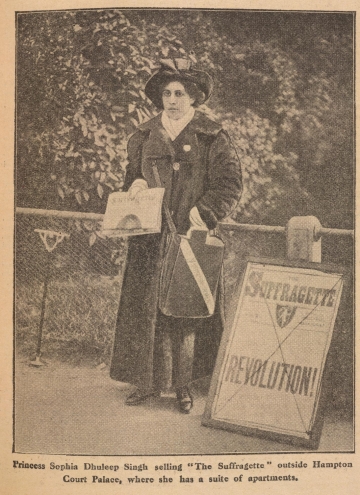Princess Sophia Duleep Singh
The full resource is FREE to all registered users of the website
If you are not already registered you can sign up for FREE website access to download the full resource.

- Born: 1876
- Died: 1948
- Occupation: socialite, nurse and campaigner
- Claims to fame: involvement in ‘Black Friday’, high social class and background, tendency towards militant activity
Her background
Sophia’s father was the last Maharaja of the Sikh Empire in India and she was born a princess. British rule in India meant that her family had handed their lands over to the British, and Sophia was born in the UK. Financially, the family suffered and Sophia’s godmother, Queen Victoria, provided her with support and a home at Hampton Court. Sophia studied chemistry at university, becoming a socialite, but a trip to India and witnessing the poverty there made her politically active.
As a suffragist
In 1909, Sophia joined the WSPU and became an active member. She took part in the physical scuffles on ‘Black Friday’ in 1910, when the police were violent towards suffrage protestors. She joined the Women’s Tax Resistance League and sold her possessions to friends and family so that they couldn’t be seized for tax payment. She spoiled her 1911 census and famously sold The Suffragette newspaper outside Hampton Court Palace where she lived. King George V was encouraged to remove her from the Palace to stop her campaigning. Sophia was arrested for taking part in physical and violent protests, but never sent to prison because of her status and name. She became a Red Cross nurse during the First World War, tending to the British Indian troops at hospital in Brighton. Afterwards, she continued working for women’s rights. Her sister, Catherine Duleep Singh, belonged to the law-abiding NUWSS. Other Asian women who supported the Votes for Women campaign included Lolita Roy and Bhagwati Bhola Nauth.
Glossary
- Maharaja of the Sikh Empire – the ruler of an independent area of India before the creation of British India
- Socialite – a person, usually of high social class, who is famous for going to a lot of parties and social events and is well known because of this
Questions
- Why was it that Sophia had an education, but still became a socialite?
- Why was King George V angry with her?
- Do you think high profile women like Sophia helped or hindered the suffrage cause?
Useful resources
- Elizabeth Crawford, The Women’s Suffrage Movement: a reference guide, 1866–1928 (Routledge, 1999)
- Anita Anand, Sophia: princess, suffragette, revolutionary (2015)
